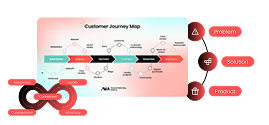Product marketers are no strangers to written communication. We write messaging, compelling positioning statements, pitch decks, webinar scripts, product blogs, and demos. The written word is key to success as a product marketer, but your ability to speak publicly about our work may be the key to advancing your career and building your brand.
Over the years, I’ve honed my public speaking skills in all kinds of settings – from leading high-stakes company all-hands and energizing sales kick-offs to developing and presenting an online course, sharing insights on podcasts, and even guiding a 3,000-person yoga class at Red Rocks Amphitheater.
Each experience has helped me manage nerves, handle curveball questions, and keep an audience engaged – whether they’re colleagues in a boardroom or yogis under the Colorado sky.
In this article, I’ll break down what I’ve learned, what’s worked for me, and what I’ve seen work for others. By the end, you’ll have some actionable steps to develop your own public speaking skills.
Why public speaking skills are essential for PMMs
When you think about product marketing leaders, the ones we engage with on LinkedIn, listen to on podcasts, and learn from through PMA courses, one skill these visionaries all have is the ability to speak publicly to share their ideas and engage with their audience.
Public speaking skills further your career advancement, increase your overall communication efficacy, establish credibility, and open doors. If you can develop your ability to speak in front of an audience, you’ll:
- Increase your confidence
- Build executive presence
- Strengthen your influence
- Open doors to leadership roles, networking events, and speaking engagements that develop your brand as a thought leader
- Enhance persuasiveness and your ability to advocate for ideas, projects, and career advancement
Even if you haven’t had the opportunity to develop public speaking skills, there are ways you can start to develop your comfort speaking in front of an audience, so you’re prepared when the time comes for you to step into a public speaking opportunity. Or, maybe you’ve had a public speaking opportunity but struggled due to fear or lack of preparation.
The good news is that anyone can improve this skill with deliberate effort and consistent practice. So, let’s explore four key strategies to master public speaking, along with actionable steps to integrate these techniques so that public speaking no longer daunts you.
Four strategies for developing public speaking skills as a product marketer
1. Develop clarity and confidence
Confidence is the foundation of effective public speaking. When you speak with clarity and assurance, your audience is more likely to trust and engage with your message.
Here’s how you can build confidence and clarity:
- Practice: The more you practice, the more natural public speaking will become. I like to practice my speeches while I’m driving by myself. Not only does it give me a chance to listen to myself speak, but it makes traffic more bearable.
- Record yourself: Watching recordings of your speeches can help identify areas for improvement in tone, clarity, and pacing. Pay attention to your body language and vocal delivery.
- Check your mindset: Nervousness is natural, but techniques like deep breathing, visualization, and power posing can help channel anxiety into positive energy. One of my fictional heroes, Rebecca Welton from Ted Lasso, has a great method for building confidence. She tries to “make herself big” (caution: the link has a curse word in it!).
This technique, the “Wonder Woman” pose, and expressive, open-mouth breathing are all great ways to harness your nerves. My advice: learn to appreciate the nerves; they mean that you care. - Be punchy: Channel your inner Emma Stratton and avoid jargon and overly complex sentences. The goal is to communicate effectively, not to impress with vocabulary.
- Remember non-verbal communication: Make eye contact, use gestures purposefully, and maintain an open posture to establish a strong presence. When I first started teaching yoga, I would hold a water bottle in front of me. I didn’t even realize I was doing it until I got feedback about it.
Notice how you’re engaging with things like laptops, slide clickers, and even your water bottle when on stage. Don’t let props become a crutch and impact your presence or engagement with your audience – there’s no need to hide!
2. Improve persuasiveness and storytelling
Persuasion is a crucial skill in public speaking, whether you’re pitching an idea, leading a meeting, or giving a keynote speech. Storytelling, in particular, is an effective way to make your messages memorable and relatable.
Here’s how to enhance your persuasive communication:
- Make it about them (not you): Want to keep your audience engaged? Show them exactly what’s in it for them. Product marketers are trained to zero in on customer pain points – public speaking is no different. Your audience could be customers, colleagues, or the entire sales team. Whatever the setting, focus on the problems they face and how your message helps solve them.
- Weave in personal stories and examples: Authentic, relatable stories help humanize your message and make it more compelling. When speaking at a sales kick-off, I like to bring up themes and quotes I heard from the reps so they feel seen and heard by product marketing.
- Appeal to emotions and logic: Balance emotional appeal with factual data to create a well-rounded argument that resonates with different types of audience members.
- Use rhetorical devices: Techniques like repetition, analogies, and rhetorical questions can reinforce your key points and enhance speech impact. You’ll likely have speaker notes if you’re using a slide deck, but try not to rely on them too heavily and have most of your talking points memorized.
- End with a strong call to action (CTA): Make it clear what you want your audience to do next, whether it’s adopting a new strategy, supporting an initiative, or simply reflecting on your message. As an example, with a CTA to partner and collaborate on materials, you can get your audience to volunteer their time. I’ve built a great network for advisory councils by using a QR code in presentations.
3. Enhance your ability to connect and adapt
Great speakers know how to connect with their audience. Engagement keeps listeners interested, while adaptability allows you to adjust your presentation based on real-time feedback.
Most people can only pay attention for about twenty-minute stretches of time. So, if you have a sixty-minute speech, you’ll need to break up the format to keep the audience’s attention from waning.
To improve audience interaction:
- Know your audience: Research your audience’s interests, knowledge level, and pain points so you can tailor your message accordingly.
- Encourage interaction: Ask questions, use humor appropriately, and invite audience participation through polls, Q&A sessions, or storytelling prompts. In a product demo, this could follow an “I do, we do, you do” model. In a sales training, this might be a chance for them to practice discovery questions or objection handling in breakout groups.
- Read the room: Pay attention to body language and adjust your tone, pacing, or approach if your audience seems disengaged.
- Use visual aids effectively: Charts, images, and slides should support your message, not overwhelm it. Keep slides simple and visually appealing. Aim for just three key points per slide.
- Be adaptable: Sometimes, unexpected challenges arise, such as technical difficulties or tough questions. Stay calm and flexible to maintain control of the situation. At my last public speaking event, a bird was trapped in the room. The audience was distracted by it, so I called attention to it so I could then rein in their attention back to my presentation.
4. Handle objections and Q&As with confidence
Handling questions and objections effectively can reinforce your credibility and showcase your expertise. Here’s how to navigate these interactions with confidence:
- Prepare for tough questions: Anticipate possible objections and rehearse your responses to avoid being caught off guard. It’s also completely okay to not know the answer and to say, “Let me get back to you on that.”
- Use the acknowledge-bridge-respond method: First, acknowledge the question or concern, then bridge it to your key message before delivering a clear response. This is a great way to buy some time for you to think!
- Stay composed under pressure: Maintain a calm demeanor, even if faced with challenging or confrontational questions.
- Reiterate key points: If a question leads to an important discussion, use it as an opportunity to reinforce your main message.
Actionable takeaways to develop your public speaking skills
Public speaking is a skill you’ll continue to develop over time. If you’re looking to up your game, here are some ways you can start to develop your skills, even if you don’t currently have a public speaking opportunity available:
- Join public speaking groups: Organizations like Toastmasters provide structured practice and feedback in a supportive environment.
- Seek speaking opportunities: Volunteer to present at meetings, lead discussions, guest speak on a podcast, or participate in panel discussions to gain real-world experience.
- Use video practice: Record your speeches, analyze your performance, and refine areas such as pacing, clarity, and non-verbal communication.
- Learn from experts: Watch TED Talks and study how great speakers use tone, gestures, and storytelling to engage audiences.
- Engage in improvisation exercises: Practice impromptu speaking to improve your ability to think on your feet and respond dynamically.
- Request feedback: Ask colleagues, mentors, or professional coaches for constructive criticism to help you refine your skills.
- Take public speaking courses: Online courses and workshops can provide structured training to build confidence and technique. See if your employer will allocate some of your learning and development budget to developing this skill!
- Develop a personal pre-speech routine: Find rituals that help you relax and focus before speaking, such as deep breathing, positive affirmations, or visualization exercises. Make yourself big, ground your feet into the floor, place your hands on your chest – any of these things can help center you and your nerves.
Parting thoughts
Public speaking isn’t just a skill – it’s an accelerator. Whether you’re presenting a project update, sharing updated messaging, or delivering a keynote speech, the ability to speak clearly and persuasively will set you apart (after all, you’re confidently doing something most people are scared of!).
By practicing regularly, developing confidence, and refining your engagement techniques, you can become a powerful and effective speaker.
Investing in public speaking skills will open doors to leadership roles, industry recognition, and networking opportunities. More importantly, it will give you the confidence to share your ideas, inspire others, and take control of your professional growth, including your personal brand development.
Start small, practice often, and seek speaking opportunities as a chance to refine your craft. Over time, you’ll master an additional communication skill that amplifies you as a product marketer.


















 Follow us on LinkedIn
Follow us on LinkedIn



.svg?v=85af970283)